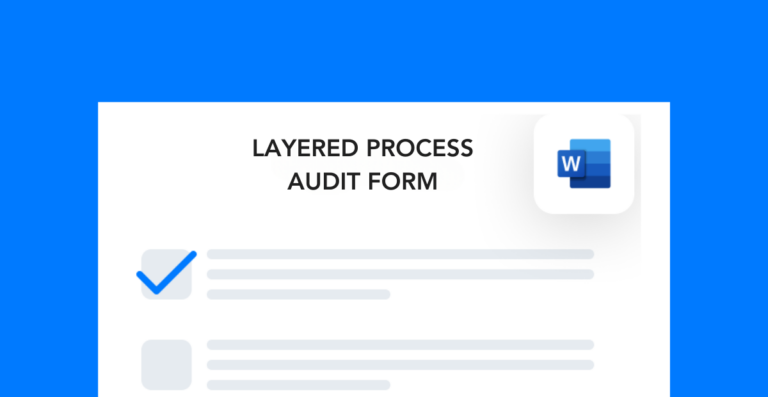Operational audits are necessary to reach your company’s goals, and most audits can be done at the departmental level. But when it comes to processes that affect company performance in a major way, a layered process audit can help you ensure success. By decentralizing your process audits, you can get a clearer picture of what’s working and what’s not.
What is a layered process audit?
A layered process audit (LPA) is the procedure of verifying proper implementation of a process at multiple levels within a company. By involving frontline employees, managers, and senior leadership, you can lower the risk of major impacts to performance, such as:
- Safety incidents
- Production slowdowns or stoppages
- Product recalls
- Regulatory citations
- Public relations missteps
- Marketing blunders
Essentially, you can apply these audits to any process that has the potential to impact the company in a big way. In fact, LPAs are very common in the manufacturing sector as a tool for auditing high-stakes production processes. But you can just as easily apply them to other areas of the business, like:
- Approving major marketing campaigns
- Making changes to internal processes
- Introducing new products to market
- Incorporating hazardous processes or materials to your operations
Doing a layered audit is about the same as doing everyday audits, except that you do it at multiple levels. Once you’ve got the concept down, you can start applying it to those essential processes within your company.
The different audit levels
The term “layered” refers to the different levels within the company that contribute to the process audit. So, there’s no specific number of layers to follow. It just depends on your company’s hierarchy and how you organize teams.
If you don’t have a certain set up in mind, you can stick with these three layers:
Layer 1: Frontline workers
This includes anyone involved in the day-to-day labor activities that generate products or services. Examples of people in this layer would include:
- Machine operators
- Customer service representatives
- Quality inspectors
- Project coordinators
Layer 2: Middle management
This second level includes anyone in a supervisory role that isn’t a part of the executive team. Here are some people who here:
- Shift supervisors
- Area managers
- Operations managers
- Regional directors
Layer 3: Senior leadership
The last layer of your audit is the senior leadership team, which includes people in these roles:
- President
- Vice President
- Directors
- Chief Officers (CEO, COO, CMO, etc.)
These stakeholders work together to verify that all elements of the process are operating correctly. They do this by performing staggered audits at routine intervals. That way, the company maintains constant oversight of critical processes.
Set the audit criteria
Start by identifying the process you want to audit and answering these questions:
- What elements or variables of this process do we want to audit?
- Who will perform the audit?
- Who will oversee the completion of the audit?
You’ll want to have an audit checklist specific to each process. Your team will use the criteria in this checklist to conduct the audit and note any abnormal or unsatisfactory results. Documenting your audits is essential if you want to be able to investigate any issues or incidents down the line.
Once you’ve determined your criteria for a process audit, you’ll need to determine how often you want each layer to do it.
Frequency of layered process audits
Each layer in the company conducts their process audits at different intervals. This ensures that the company never loses sight of important areas of performance.
It’s up to you how often you want each group to do their audits, but here’s a guideline you can follow:
- Layer 1: Daily or weekly
- Layer 2: Weekly or monthly
- Layer 3: Quarterly
For high-stakes processes, I wouldn’t recommend stretching frequencies past the quarterly interval. That’s because a quarter is already a long time to go without reviewing a major process. Waiting any longer than that can make the senior leadership team out of touch with what’s happening and may lead to an incident.
Schedule layered process audits
When you know how often each layer should do their audits, you need to schedule them in advance. One of the biggest mistakes you can make is to try and do your LPAs without planning them first. And that’s because if you don’t make it a priority ahead of time, the operation will get in the way.
You can use audit software to easily schedule a layered process audit. Software makes this easy by allowing you to schedule a different audit interval for each group involved. That way, senior leadership has their quarterly audit date set well in advance. Meanwhile, the frontline workers will make the process audit part of their standard work.
If you don’t have software, you can do this manually with an old-fashioned calendar or spreadsheet. When taking the manual route, just make sure to have a way to remind yourself when audits are upcoming (e.g., phone notifications, digital calendars, etc.).
Layered process audit example
After deciding the criteria and frequency for your audits, you should have everything you need to start conducting them. Here’s an example of what this looks like.
A meal kit delivery service needs to ensure that their products don’t cause a foodborne illness outbreak. They need to carefully monitor the temperature of their meal kits at all steps in the process. This includes the temperature of the raw ingredients, the packaging process, and all the way to delivery on the customer’s doorstep.
To do this, they’ll implement a layered process audit for product safety. It will go as follows:
Layer 1: Frontline employees will check and document the temperature of product batches every two hours. These records will be attached to the batch lot code in the system.
Layer 2: Shift supervisors will audit the temperature logs twice per shift to make sure workers are completing their checks. They’ll also make sure that any temperature variances are addressed appropriately so the products stay safe.
Layer 3: Department managers will review temperature logs each week and discuss any concerns with their teams to make sure no process changes are needed.
Layer 4: Senior leadership will discuss any new process changes to address product safety during their monthly meetings. During this time, they will also review any potential recalls or customer complaints related to product safety and determine whether to take additional action.
From this example, you can see how an LPA helps maintain the integrity and effectiveness of a process. Each layer can address concerns before they cause problems. The key is to fully commit to your audits. If one group doesn’t perform their audits on time or consistently, it will impact the overall outcome.
Have an accountability system
You need to hold everyone accountable to their role in the layered process audit. If you track all your audits with action tracking software, you can easily see who’s assigned to complete each task and when they act. That way, you don’t have to rely on a paper checklist for all the information you need.
Specifically with layered audits, having a digital version of the audit data helps with visibility for everyone involved. Senior leaders can quickly review all the audit results from a software platform, as opposed to waiting for an update from managers. For decentralized operations, or those with a lot of locations, a digital approach reduces the likelihood of missing audits.
Frontline ACT audit tracking software
Frontline ACT is an easy-to-use action tracking software solution that you can use for all your operational audits. It allows you to:
- Generate action item reports
- See the status of all your audits
- Schedule and assign process audits
- Keep detailed logs of all audit tasks
- Build custom audit checklists and forms
Because Frontline ACT is a tracking system, you can apply it to pretty much any area of your operation. Aside from audits, you can use it for other events like recalls, inspections, and safety incidents.
To learn more about Frontline ACT audit tracking software, check out the webinar below or book a demo with our sales team.
Other posts you might like…
No posts

